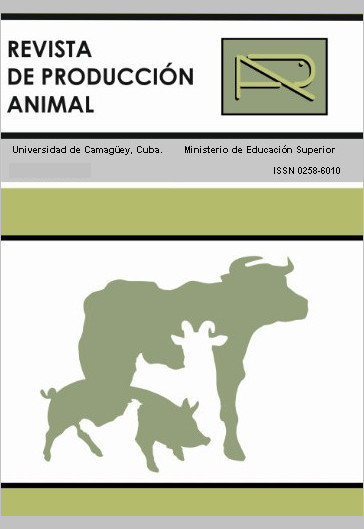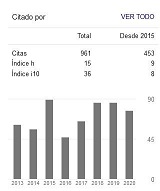Efecto del Benzoato de Estradiol en el tamaño del folículo y cuerpo lúteo en vacas Holstein sincronizadas con D-Cloroprostenol.
Resumen
Se evaluó el efecto de dos tratamientos, las granjas y la condición corporal en el tamaño del folículo y cuerpo lúteo. En uno de los tratamientos se aplicó D-Cloroprostenol (150 ug) y en el otro, D-Cloroprostenol (150 ug) y Ben-zoato de Estradiol (1mg). Se formaron dos grupos de 32 vacas Holstein cada uno, pertenecientes a las granjas Nero e Irquis, en Cuenca, Ecuador. Se tomó en cuenta la condición corporal (2,75-3,50), el número de partos fue de 1-6, las granjas (Irquis y Nero) y edad de los animales (3-10 años). Se usó ecografía a 0; 3 y 7 días, así para en el primer momento medir el cuerpo lúteo, luego el folículo dominante y la última el cuerpo lúteo. Se realizó un análisis de va-rianza factorial. No se encontraron diferencias significativas para el tamaño del folículo por efecto de ninguno de los factores ni la interacción, no así en el tamaño del cuerpo lúteo, donde se registraron diferencias s ignificativas (P < 0,05) para los tratamientos y para la granja. El valor fue superior en 0,33 cm en el tratamiento con Benzoato y de 0,36 cm en la granja Irquis respecto a Nero. La aplicación del tratamiento con Benzoato y el mejor manejo de la granja Irquis tuvieron influencia importante en la formación y desarrollo del cuerpo lúteo.
Effect of Estradiol Benzoate on the Size of Follicle and Corpus Luteum of Holstein Cows, Treated with D-Cloprostenol.
ABSTRACT
The effect of two treatments, farms, and body shape on the size of the follicle and Corpus Luteum, were evaluated. D-Cloprostenol (150 ug) was used in one of the treatments; in the other, D-Cloprostenol (150 ug) and Estradiol Ben-zoate (1mg), were used. Two groups of 32 Holstein cows each, from Nero and Irquis farms in Cuenca, Ecuador, were set up. Body condition (2.75-3.50) was considered. The calving number was 1-6, the farms (Irquis and Nero), and animal age (3-10 years). Ultrasound scanning was used on days 0; 3 and 7, in order to measure the Luteum first, then the dominating follicle, and finally, the Corpus Luteum. Factor variance analysis was performed. No significant differences were found for follicle size due to any factors; nor due to interaction. Concerning luteum, significant differences (P < 0.05) were observed for the treatments and for the farm. The values were 0.33 cm higher for the treat-ment with Benzoate, and 0.36 cm, on Irquis Farm, in comparison to Nero. The treat ment with Benzoate, along with better husbandry on Irquis played a critical role in the appearance and evolution of the luteum.
Descargas
Citas
BOLDT, A.; BECKER, F.; MARTIN, G y NUNBERG, G. (2015). A Phenotypicall Approach to the Effects of Productions Traits, Parturition, Puerperium and Body Condition on Commencement of Luteal Ac-tivity on High Yielding Dairy Cows. Anim. Reprod. Sci., 157, 39-43.
GARCÍA, R. (2003). Conferencia sobre manejo y alimentación de ganado lechero en el Trópico, Curso de Posgrado, Tabasco, México.
LÓPEZ, H.; SATTER, L. D. y WILTBANK, M. C. (2004). Relationship between Level of Milk Production and Oestrus Behaviour of Lactating Dairy Cows. Anim Reprod Sci., 81, 209-23.
MCDOUGAL, S.; COMPTON, C. R.; ANNIS, F. M. (2004). Effect of Exogenous Progesterone and Oes-tradiol on Plasma Progesterone Concentrations and Follicle Wave Dynamics in Anovulatory Anoestrus Post Partum Cattle. Anim Reprod Sci., 84, 303-14.
MOUSSA, M.; SHU, J.; ZHANG, X. y ZENG, F. (2015). Maternal Control of Oocyte Quality in Cattle, a Review. Anim. Reprod. Sci., 155, 11-27.
PASTZINCA, MONIKA y MOLINA, J. (2007). Compendio de Reproducción Animal, (9ª edición). Paraguay-Uruguay: Intervet.
NARVÁEZ, J. (2015). Comunicación personal.
PARR, M.; CROWE, M.; LONERAGAN, A.; EVANS, A. y FAIR, M. (2015). The Concurrent and Carry Over Effects of Long Term Change in Energy Intake Be-fore Insemination on Pregnancy in Heifers. Anim. Reprod. Sci., 157, 87-94.
RODRÍGUEZ, L.; ABUELO, A. y BEJAR, C. (2012). El uso de la ecografía Doppler color en la reproducción. Extraído el 12 de julio de 2014, desde www.portalveterinario.com.html.
SATHESHKUMAR, S.; BRINDHA, K. y ROY, A. (2015). Natural Influence of Season on Follicular, Luteal, and Endocrinological Turnover in Indian Crossbred Cows. Theriogenology, 84, (1), 19-23.
STEVENSON, J. S.; TIFFANY, S. M.; LUCY, M. C. (2004). Use of Estradiol Cypionate as a Substitute for GnRH in Protocols for Synchronising Ovulation in Dairy Cattle. J. Dairy Sci., 87 (3), 298-305.
SZELENYI, Z.; REPASI, A.; MELO DE SOUSA, N. (2015).
Accuracy of Diagnosing Double Corpora Lutea and Twin Pregnancy by Measuring Serum Progesterone and Bovine Pregnancy-Associated Glycoprotein 1 in the First Trimester of Gestation in Dairy Cows, Theriogenology, 84, (1), 76-81.
THATCHER, W.; MOREIRA, F.; PANCARCI, S. M.; BARTOLOME, J. A. y SANTOS, J. P. (2002) Strategies to Optimize Reproductive Efficiency by Regulation of Ovarian Function. Dom Animal Endocri-nol., 23, 243-254.
UGARTE, J. (1995). Factores no nutricionales de manejo de vacas lecheras. Evento XXX Aniversario del Instituto de Ciencia Animal, Cuba.
WALSH, S. W.; WILLIAMS, E. y EVANS, A. (2011). A Review of the Causes of Poor Fertility in High Milk Producing Dairy Cows. Animal Reproduction Science, 123, (3-4), 127-138.
Wiltbank M., Lopez H., Sartori R., Sangsritavong S., Gumen A. (2006). Changes in reproductive physiology of lactating dairy cows due to elevated stero-id metabolism. Theriogenology; 5:17-29.
Los autores de los artículos publicados en RPA retienen los derechos de autor de su trabajo, de marca y patente, y también sobre cualquier proceso o procedimiento descrito en el artículo, así como a compartir, copiar, distribuir, ejecutar y comunicar públicamente el artículo publicado en la RPA o cualquier parte de aquel siempre que indiquen la fuente de publicación (autores del trabajo, revista, volumen, número y fecha), pero están de acuerdo en que la revista publique los trabajos bajo una licencia Creative Commons.
![]() Licencia Attribution-NonCommercial 4.0 International (CC BY-NC 4.0)
Licencia Attribution-NonCommercial 4.0 International (CC BY-NC 4.0)






































